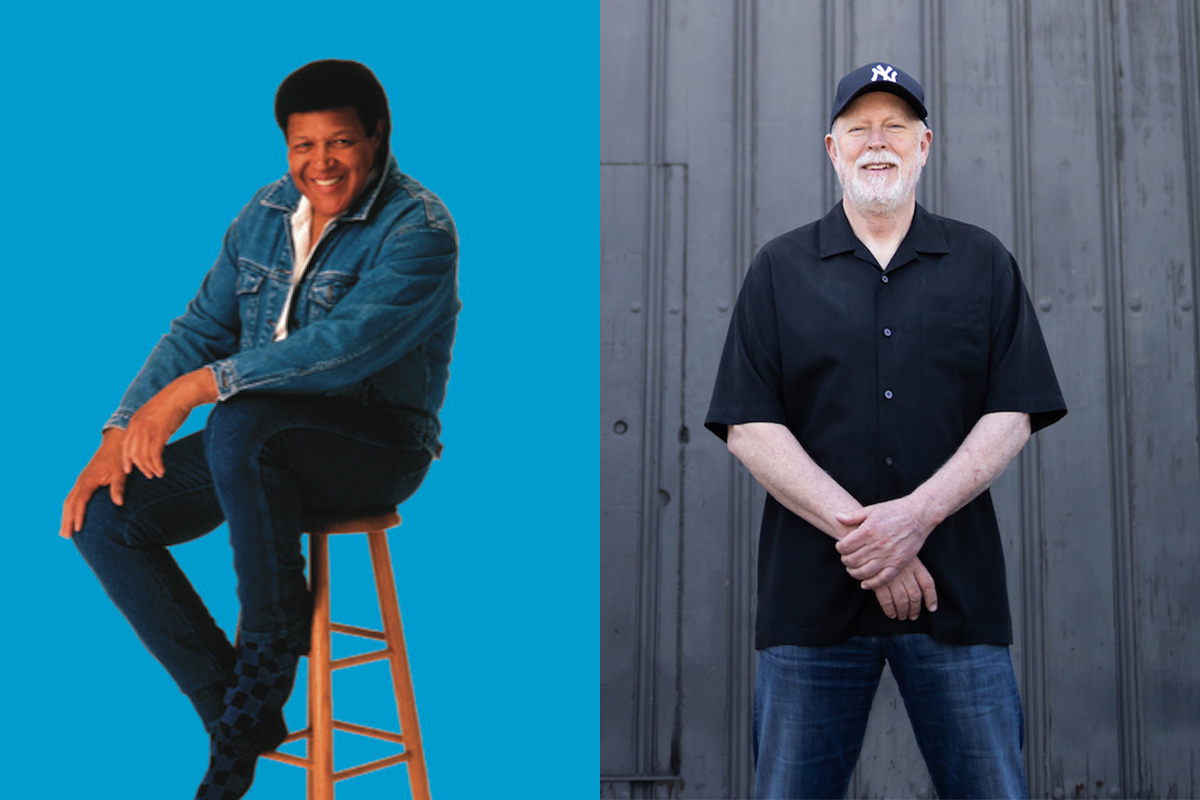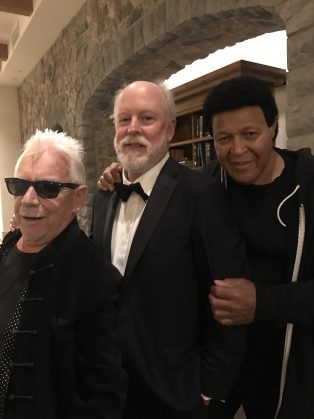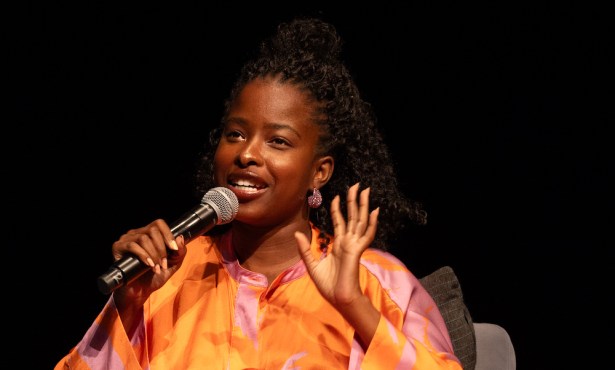Chubby Checker Twists Away
at Free Santa Barbara
Block Party
The Man Who Taught America
How to Shake It Comes to Town
By Nick Welsh | May 18, 2023

Sir Isaac Newton was just 23 when he discovered the law of gravity to which none of us, no matter how airborne, are immune. That was in 1666. Albert Einstein was 26 when he “discovered” his general theory of relativity, still unfathomable to most people 118 years later.
It would be a cherubically plump, fresh-faced 17-year-old African American singer named Ernest Evans who helped White Americans, by electrifying its youth and awakening its elders to the fact that they’d been endowed by their creator with both hips and ass, not to mention the inalienable joy that comes from shaking both.
This discovery occurred in the summer of 1960.
By that time, Evans had changed his name to Chubby Checker, and his hit song — “The Twist” — had spawned a dance craze that would span not just the globe but the whole generational divide. For the first time, adults — not just teenagers already mesmerized by Elvis — found themselves sucked onto the dance floor by the insinuating grooves of R&B, then regarded not just as “race music” but also as something dangerously lascivious.
“I have no objection to the Twist as such,” intoned the staid and stalwart Dwight D. Eisenhower shortly before leaving the White House, “but it does represent some kind of change in our standards. What has happened to our concepts of beauty, decency, and morality?”
Fortunately, not everyone was similarly troubled. National magazines ran photos of America’s glamorous First Lady, a 31-year-old Jackie Kennedy, doing a mean Twist at White House parties. Secretary of Defense Robert McNamara was also said to cut a mean rug. But that was before we began bombing Hanoi.
The song would top the charts, not just in 1960, when “The Twist” first hit the airwaves, but two years later when it came back for a sonic rebound, an unprecedented achievement to this day.
On Saturday, May 20, Chubby Checker, still going strong at 81 years old, will be in Santa Barbara, twisting away to celebrate the 150th anniversary of the Lobero Theatre. Joining the free block party in front of the theater on Canon Perdido Street will be Santa Barbara’s ever-ubiquitous Spencer Barnitz and Glen Phillips, as famous today for just being Glen Phillips as he ever was for being part of Toad the Wet Sprocket.
Making all this happen is Earl Minnis, a man few of his fellow Santa Barbarans have ever heard of. Minnis, who sports shorts no matter the weather, is a real estate mogul who has made a lot of money. Fortunately for Santa Barbarans, Minnis knows how to use that money. He spends it on what he likes. But what he loves — not merely likes — more than anything else is music. He loves it absolutely, ecstatically, studiously, religiously, obsessively, compulsively, and extravagantly. He loves it with the excitement of a kid. “I was born on Sunset Strip,” he says with a laugh.
Minnis especially loves rock music rooted in the late 1960s and early 1970s. And, fortunately for Santa Barbara, he loves the Lobero Theatre.
The Lobero Theatre was dreamed, schemed, built, nurtured, and ultimately lost by José Lobero, an Italian immigrant — not to mention musical visionary, saloon owner, and by all historical accounts a genuinely wild-assed trombone virtuoso. Ultimately, Lobero committed suicide rather than endure financial ruin, the result of bad investments. Along the way, he changed his first name from Giuseppe to José to better blend in with the dominant Spanish-speaking Santa Barbara of the time.
At 150 years old, and still going strong, the Lobero remains Santa Barbara’s single most magically intimate — and affordable — venue for an astonishingly wide array of musical genres. So thank you, José or Giuseppe or whatever you want to call yourself all these years later.
And many thanks to all the people along the way who’ve kept Lobero’s dream so alive for so long. And that now includes Minnis.
Earl Minnis is a genuinely tough guy. Open, direct, impetuous, decisive, expansive, tender, and enthusiastic. But tough. He made his bones in a tough business, flipping houses he bought at distress sales held on courthouse steps. He estimates he’s flipped about 2,500 houses over the years, earning the right to sit at the table with legendary Los Angeles real estate operator tough guys known as “The 40 Thieves.”
But as tough as Earl Minnis may be, he remains a big kid when it comes to music and the people who make it. The light of his Big Wow has never dimmed. He loves hanging out with musicians — including some of the great names of an era: Patti Smith, John Kay of Steppenwolf fame, Eric Burdon, Alan Parsons, Steve Miller, and Graham Nash — swapping stories, inhaling their ether. Along the way, he’s bankrolled their appearances at private performances in town. Or at the Lobero. Like he says, he loves music, and he loves it generously.
Accomplished Missions
Four years ago, Minnis brought the Steve Miller Band to the Lobero for a concert to benefit Notes for Notes, a music program targeting young kids that started in Santa Barbara but has since gone national.
Last year, Minnis brought the proto-punkabilly band The Blasters back to the Lobero, from which they’d been soundly banished by theater management 40 years before after a wild concert. Theoretically, all rock bands were supposedly banished after that concert.
Back in 1982, The Blasters had a die-hard following of fans who went too crazy. Apparently, they enthusiastically began jumping up and down on the seats. The band didn’t think it was their job to calm down the crowd or save the chairs. In 2022, Earl Minnis persuaded the Lobero to bring The Blasters back in from the cold, and he also persuaded The Blasters’ brothers, Dave and Phil Alvin, to patch up their long-standing feud and perform together. Minnis bankrolled the concert; no seats were reported injured.
Minnis, who grew up in West Covina, was 13 when he attended his very first concert; it was Eric Burdon and The Animals. Decades later, Minnis would host Burdon’s 75th birthday bash, a concert Minnis arranged at Ojai’s also-magical venue the Libbey Bowl. “How cool is that?” he asked.

Minnis was poised to bankroll the Lobero’s anniversary bash for David Crosby, the famous local bad boy who made good. But Crosby, infamous for his unrepentant irascibility and self-destructive lifestyle, died days before the concert date. Jack Johnson stepped in for Crosby and did so, by all accounts, by displaying a decency that in today’s context qualifies as heroic — including playing an epic concert in a totally electrically blacked-out theater.
Chubby Checker is another story.
Minnis met Chubby Checker through Catherine Remak, most famous as radio host on K-LITE, but also a power in Santa Barbara’s massive nonprofit universe. Remak, who knew Minnis slightly, has long been active with the Council on Alcoholism and Drug Abuse (CADA). She volunteered at their fundraising galas at the Bacara, which often feature great longtime rock stars. When Minnis heard (from his pool man) that he had missed seeing Peter Noone (of Herman’s Hermits fame) performing with Eric Burdon, he quickly got on the horn with Remak and just as quickly became a major donor to CADA. When Chubby Checker performed at a subsequent CADA fundraiser, Earl Minnis would be sitting next to him at dinner. That was, as both men have attested, the beginning of a beautiful friendship.
“He is just the greatest guy,” Minnis gushes. Has Chubby Checker lost a single step in the 64 years since first recording “The Twist”? Not according to Earl Minnis, who says Chubby Checker always delivers. He sings, he dances, and he descends from the stage and immerses himself in the crowd. Women in the audience — of all ages — reciprocate by taking to the stage en masse. Much booty-shaking ensues. What’s not to love?
“It’s like watching Clark Kent go into the phone booth,” Minnis reported. “He goes into the booth an 81-year-old man and comes out a 30-year-old Superman. He’s got everything but the cape. It’s amazing.”
Minnis hosted a private, friends-only birthday bash for Checker last year at SOhO. When Minnis talks about that night, he lifts his finger into the air to check off an imaginary box and says, with total delight, “Mission accomplished.”
He makes exactly the same sign when describing the night he and Checker went to the Santa Barbara Bowl to see Bonnie Raitt. When she learned who was in the audience, Raitt had the house lights shined on Checker so all 4,500 people in the crowd could stand and applaud a living legend. “Mission accomplished,” Minnis said again.
Right now, Minnis loves the idea of throwing a block party for Santa Barbara, his adopted hometown since he first stumbled here, somewhat arbitrarily, in 1995, and for the Lobero Theatre itself. In navigating the reams of red tape so endemic to Santa Barbara, it has not hurt Minnis any that he pals around with the likes of Mayor Randy Rowse as well as the city’s politically gifted former fire chief Pat McElroy, whose own musical enthusiasms are nothing less than encyclopedic. And he promised to bring Chubby Checker.
In the Beginning, There Was the Twist

If the Twist didn’t exist, someone would have had to invent it. It will knock the grump out of anybody. It’s an infinitely joyous interruption. Playful and sexy, it won’t be ignored. It can’t be. Your hips won’t allow it. Like one of Isaac Newton’s laws of physics, your lips have to smile.
How the Twist happened — and how Chubby Checker came to sing the accompanying song — is a mystery to be savored. Some sources trace the Twist back to music enslaved people brought to America from the Congo. According to another account, the Twist first surfaced in 1912 with a song called “Messing Around,” even then a euphemism for sex. In 1928, a song called “The Twister” came out about the same time Jelly Roll Morton recorded “Winin’ Boy Blues,” which included the line “Mama, Mama, look at Sis / Lord, she’s out on the levee doin’ the twist.”
By the 1950s, a gospel group — Brother Joe Wallace and the Sensational Nightingales — had come up with something pretty close to what we have today. But, it being about sex, the Nightingales had to pass it on to Hank Ballard and The Midnighters, who in 1959 would be the first to record what would become “The Twist.” Ballard would get credited as the songwriter as well. His version made it to number 28 on the charts, making it a modest success. But Ballard was too hot, too Black, and way too raunchy to be allowed to take it all the way to the top.
While that version didn’t achieve mainstream success, the song caught on with young listeners in Black regional markets such as Baltimore and Philadelphia. Buddy Deane, who hosted a teenage music and dance TV show in Baltimore, brought the song to the attention of promoter and producer Dick Clark, who by 1958 had gone national with his phenomenally successful television show American Bandstand. Clark heard something in the song. “It looks like it’ll catch on,” he would write later. He would be right. But he also knew he needed another artist to perform it.
Enter Ernest Evans, a young kid from Spring Gully, South Carolina, where, he would later tell a reporter for Forbes, he grew up “Amish.” By that, Evans meant there was no water, no power, no electricity, no nothing. When he was 4 years old, Evan’s mother took him to see country singer Ernest Tubb, also known as the Texas Troubadour. It was if he’d been struck by lightning. “I knew right then I never wanted to do anything else,” Checker said in a recent interview. “That was my dream. So every time I go and perform, I am living the dream I first had when I was 4 years old.”
At age 11, Evans and his family moved to Philadelphia, where he grew up living in the projects, singing on street corners, and working as a chicken plucker for Ernest Holt’s fresh farm poultry operation. By then, Evans had developed into a truly gifted musical mimic who did convincing impersonations of Elvis Presley and Fats Domino. Evans was even encouraged to sing at work over the company loudspeakers.
In fact, it was Holt who brought Evans to the attention of Dick Clark. It was Clark’s wife who dubbed Ernest Evans “Chubby Checkers,” an obvious riff on Fats Domino.
(Many eons later, Hewlett-Packard would unveil a computer app also called the “Chubby Checker.” This device allegedly enabled the user to determine the size of a man’s penis by somehow correlating it to his shoe size. Chubby Checker sued, arguing his brand was being damaged. A judge agreed. But before the case could go to trial, Hewlett-Packard would settle and withdrew the app from the market.)
On July 9, 1960, Chubby Checker went into the Philadelphia music studio run by Cameo-Parkway Records and recorded what would become his version of “The Twist.” It took all of 45 minutes, Checker recalled. Four takes. The engineer wanted to do one more. Checker had been flat on one of the notes in the line “Daddy’s sleeping and Momma ain’t around.” Checker refused: “I said, ‘Nope.’ I was in high school. I had homework I needed to do. I said, ‘Sorry, that’s it.’ ”
A month later, Chubby Checker appeared on American Bandstand and performed the song. It just blew up. He would liken the experience to winning the Nobel Prize. When the dust finally settled, no fewer than 300 different recordings of songs with the word “twist” in the title would be released. Some artists recorded songs with no mention of twisting in them, but put the word in the title anyway.
Part of the song’s appeal lay in how easy the dance was to do. Despite warnings issued by the American Medical Association that people over the age of 40 should avoid the Twist — to prevent possible sacroiliac injuries — the dance was so simple and fun that anyone could do it. Even White people. Perhaps especially White people. “You just pretend that you’re drying off your bottom with a towel, like you just got out of the shower,” Checker instructed, “while putting out a cigarette with both feet.”
Checker promoted the song tirelessly, hitting every record hop he could find. “I campaigned it,” he exclaimed. “I was doing 15 appearances a week, wherever there was a disc jockey.” Before the release of “The Twist,” Checker had been so worried about his musical future that he asked his mother, fiercely and devoutly religious, to intercede with the Almighty on his behalf. She would later tell him that an angel came to her in a dream and told her that Checker would have a song that would cover the world. But it would be someone else’s song.

But when “The Twist” exploded, Checker said his mother was none too pleased. “She said, ‘You’re going to hell,’ ” he recalled. “Anybody involved with the church had a problem with rock ’n’ roll.” To amplify his point, Checker added, “Listening to ‘The Twist’ was like taking a girl in 1945 to Coney Island wearing a bikini.”
Hank Ballard’s reaction was, well, mixed too. The tracks, he sniffed, were “weak.” Regardless, the reality was that Ballard did exceedingly well from the royalties generated by “Twist” sales. And those sales were driven by Chubby Checker’s version. “The Twist,” Checker pointed out, hit number one on Billboard’s Hot 100 list in 1960 and stayed there until 2021. No other song will ever match that record, he stated.“Mr. Ballard wrote ‘The Twist,’ and I thank him for that,” Checker stated. “But everything else belongs to me, thank you. All I know is Chubby Checker took a hold of it and it still belongs to no one else.”
But more than anything, Checker said he takes pride in changing the fundamental way people dance. It used to be that people touched while dancing; they held each other tight or swung each other all over. But after the Twist, dance partners stood apart from one another while moving to the beat. “I’m looking at her, and she’s looking at me, and I’m looking back at her and how sexy she looks,” he said. “And we’re dancing with each other but apart. That’s the style we’ve done every day since the Twist. Chubby Checker changed the dance floor. No one else can make that claim. I still call it the biggest thing that’s happened in American show business.”
As for his performance at the Lobero block party inspired, instigated, and underwritten by his friend Earl Minnis, Checker said, “When I get there, I want to see wall-to-wall people. We’re going to rock it out.”
The party starts at 3 p.m. and goes ’til 8. So dust off those dancing shoes.
The 150th Ovation Celebration Block Party featuring Chubby Checker & The Wildcats with special guests Glen Phillips, Spencer the Gardener, and the La Boheme Dancers takes place in front of the Lobero Theatre (33 E. Canon Perdido St.) on Saturday, May 20, at 3 p.m. See lobero.org.




You must be logged in to post a comment.